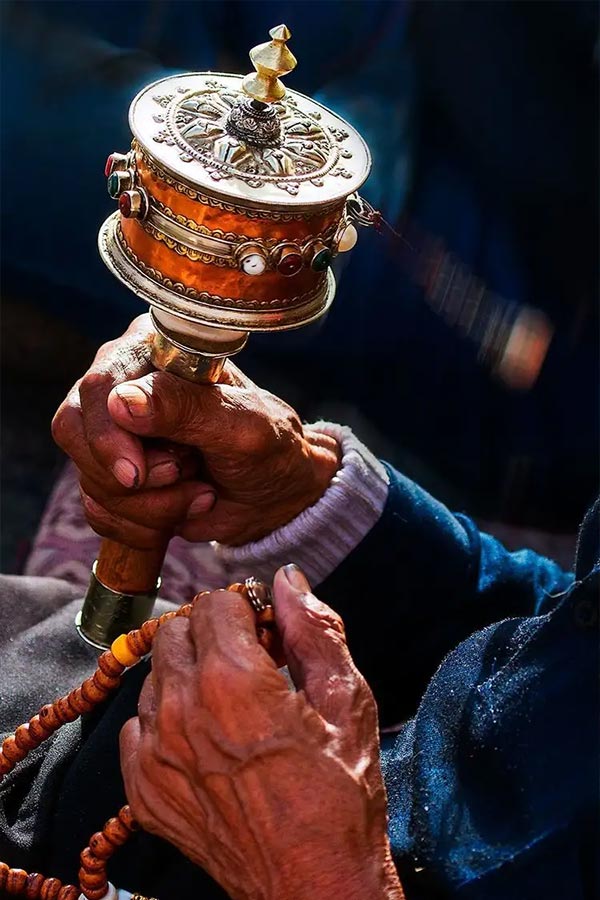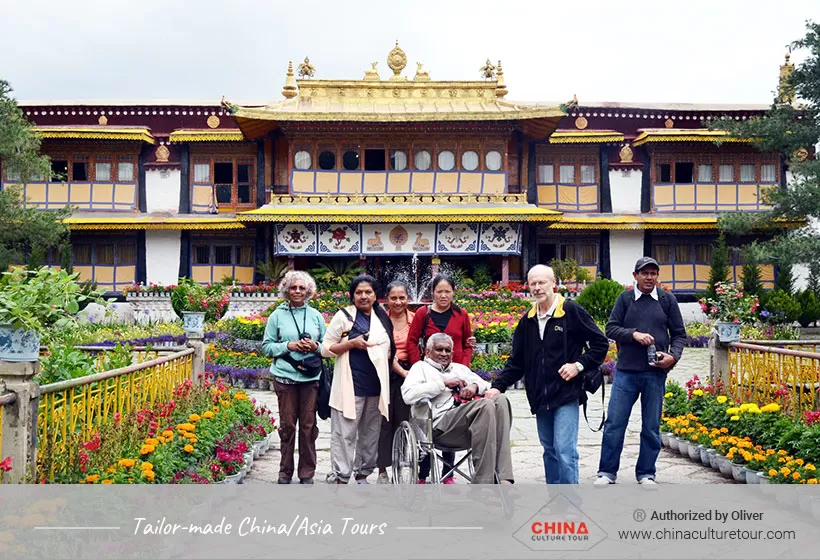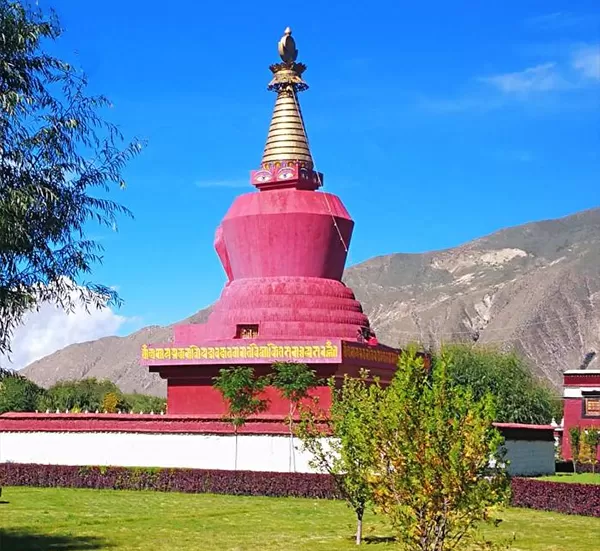Tibet Weather: the Best Time & Seasons to Visit & Travel
Tibet travel guide based on the four different seasons
Tibet's climate is unique and complex due to its topography, landforms, and atmospheric circulation. Generally, the climate is characterized by cold and dry conditions in the northwest and warm and humid conditions in the southeast. There is a significant climate difference between southern and northern Tibet. The southern valleys, influenced by warm and humid airflows from the Indian Ocean, are mild and rainy, with an average annual temperature of 8°C, the lowest monthly average of -16°C, and the highest monthly average exceeding 16°C. The northern plateau has a typical continental climate, with an average annual temperature below 0°C, a freezing period lasting up to half a year, and July temperatures not exceeding 10°C. The rainy season often features nighttime rain, while winter and spring are marked by strong winds.
Tibet's dry and rainy seasons are distinctly separate, with the dry season typically running from October to April and the rainy season from May to September, accounting for about 90% of the annual precipitation. Precipitation also varies significantly across regions, decreasing from southern to northern Tibet. Additionally, Tibet receives the most solar radiation in China and has the longest sunshine duration nationwide.
The Best Time and Seasons to Visit Tibet
In terms of climate, the best time to visit Tibet is from March to October, with June to September being the most suitable season. During this period, Tibet experiences summer, with pleasant weather and beautiful scenery.
However, due to the unique terrain of Tibet leading to significant climate variations, the optimal travel time may differ accordingly.
What is the best time to visit northern Tibet to Ngari and Nagqu?
The best time to visit the Northern Tibetan Plateau is from July to September. The region boasts unique high-altitude landscapes, with an average elevation above 4,500 meters, making it the coldest area in Tibet. Therefore, it is advisable to travel during the relatively warmer summer months.
What is the best time to visit eastern Tibet to Qamdo?
The best time to visit the mountain and canyon areas of Eastern Tibet is in May, June, and September. During winter, the climate in Eastern Tibet is cold, with frequent heavy snowfall that can block roads. In summer, the region experiences heavy rainfall, which can lead to landslides. Therefore, spring and early autumn are the most suitable times for travel.
What is the best time to visit southern Tibet to Lhasa, Shigatse, Shannan and Nyingchi?
The best time to visit the southern valleys of Tibet is from May to September. During this period, the climate in southern Tibet is at its best, with the highest oxygen levels and the most beautiful natural scenery, making it an ideal time for travel. Additionally, those planning to visit Mount Everest should aim for May. This is when the mountain is free from monsoon interference and heavy rainfall, with more clear days and stable weather, providing the best opportunity to view and experience Everest.
Tibet Weather in Four Seasons & What to Wear and Bring
Spring (March to May)
Taking Lhasa as an example, spring arrives slightly later than in inland areas, with average temperatures ranging from -4°C to 11°C. Vegetation along the banks of the Lhasa River begins to revive, and farmers start their planting activities. However, the grass on the nearby mountains doesn't fully green until mid-June. In the southeastern region like Nyingchi, where vegetation is more abundant, spring brings blooming peach blossoms, creating picturesque scenery. Meanwhile, in northern Tibet, places like Nagri and Nagqu still experience heavy snowfall during this season. Spring in Tibet is characterized by strong winds and dry weather, with snow remaining on many main mountain passes and roads.
The spring tourism season in Tibet is somewhat complex. Early April marks the peak season in southern Tibet, where the warm weather and blooming flowers attract many tourists. Nyingchi's Peach Blossom Festival is particularly popular, drawing large crowds. Consequently, travel costs to southern Tibet may be slightly higher during this period. The rest of the time, Tibet experiences either low or regular tourist seasons, making it a good option for those looking to avoid peak travel times.
What to Wear and Bring in Spring
Given the significant temperature differences between day and night in spring, it is recommended to wear a warm jacket or cotton coat in the early morning and at night, and to remove these layers at midday when it is warmer, with breathable single layers suitable for enjoying the sunshine. Due to Tibet's high average altitude, it is essential to carry medication for altitude sickness and sun protection products to mitigate the effects of high-altitude conditions and UV radiation. For those planning to visit the northern plateau or Mount Everest, high-quality, warm sports shoes or hiking boots are advisable to protect your feet.
Summer (June to August)
In summer, many places in Tibet become accessible, with average temperatures ranging from 9℃ to 28℃ and sufficient oxygen levels. The Nyingchi region, with its lower altitude, experiences abundant rainfall, particularly during the rainy season in June and July. Travelers might encounter roadblocks due to landslides, and the changing weather can diminish the appeal of many scenic spots. However, with proper planning, you can still enjoy the herds of cattle and sheep on the lush grasslands of Naqu, making your trip worthwhile. Moreover, June and July are the blooming season for rapeseed flowers in southern Tibet, including Lhasa, Shigatse, and Shannan, and by late July, the barley harvest begins in many areas.
Summer marks the peak tourist season in Tibet, especially in August, which sees the highest influx of visitors and increased costs for accommodation and travel. However, this is also when the services at tourist sites are at their best, and the scenery and weather are most favorable for sightseeing. Therefore, if you plan to visit Tibet during this time, it's crucial to weigh the pros and cons, plan your trip in advance, and book tickets and accommodations early.
What to Wear and Bring in Summer
Since this period is also the rainy season, with most rain concentrated in southeastern Tibet and occurring mainly at night, it's advisable to bring rain gear when traveling in southeastern Tibet, waterproof and non-slip shoes, and a few warm jackets for nighttime use. Additionally, given the strong sunlight in Tibet, it's essential to carry a hat, sunglasses, sunscreen, and other sun protection items.
Autumn (September to November)
Autumn is considered the golden season for traveling in Tibet, with average temperatures ranging from 16℃ to 20℃. The climate during these months is generally favorable, with suitable temperatures and sufficient oxygen levels. Both low-altitude areas like Nyingchi and remote regions such as Nagqu and Ngari in northern Tibet are accessible. It is the best time to visit Ngari, as the grassland's green period and growth season last from mid-June to early October. Despite the favorable travel conditions, visitors should be aware that the high-altitude climate is unpredictable, and some high-altitude areas may start experiencing snowfall as early as October, so it is crucial to be well-prepared for such conditions.
Due to the Mid-Autumn Festival and National Day holidays, Tibet transitions from a relatively calm period in early September to a peak season in early October. This time marks the last small peak of the year for tourism in Tibet and showcases the most magnificent autumn scenery. Therefore, proper planning is essential before traveling. After this period, Tibet gradually enters a prolonged off-season.
What to Wear and Bring in Autumn
As temperatures drop in autumn, visitors to the northern Tibetan plateau should pay close attention to staying warm by bringing sweaters, down jackets, and other warm clothing. The temperature difference between day and night can be significant, and the weather is often unstable, so monitoring weather changes and dressing appropriately is necessary. The dry and variable weather can also cause colds or other symptoms, so bringing cold medicine, antibiotics, and vitamins is advisable. Additionally, to combat the dry climate, it is recommended to carry moisturizing products such as lotion and lip balm.
Winter (December to February)
In winter, except for the southeastern areas, Tibet experiences its monsoon season from November to March or April of the following year, with the strongest winds occurring in February and March. During this period, temperatures in most regions drop below 0℃. The clear blue skies and bright sun of winter provide excellent conditions for viewing glaciers and snow-capped mountains. Regions like Nagqu experience heavy snowfall in winter, while southern areas like Lhasa and Shigatse have relatively warm daytime temperatures and low snowfall. This season also features many traditional Tibetan festivals, offering visitors a rich cultural experience.
Winter in Tibet is generally a low season for tourism, providing a peaceful and serene highland experience. However, during the Chinese New Year, Tibet sees a brief peak season, giving visitors a unique festive atmosphere. It's important to note that snowfall can make roads challenging for self-driving tourists.
What to Wear and Bring in Winter
The temperatures in Tibet during winter are typically very low, especially in northern regions where temperatures remain below 0℃. Days are short, nights are long, and strong winds are common, so warm and windproof clothing is essential. However, places like Lhasa can reach around 10℃ during sunny days, making daytime outings more comfortable. Due to the high altitude, the winter sun in Tibet is quite intense, necessitating protection against UV rays with sunglasses and sunscreen, as well as adequate hydration and moisturization. It's also crucial to bring oxygen supplies or medication to cope with the lower oxygen levels.
Tibet Weather by Month/Year Round
If you can freely choose when to travel to Tibet, it is recommended to select the most suitable month based on your interests and preferences. If you don't have the flexibility to choose, it is advisable to understand the advantages and disadvantages of traveling to Tibet in each month. According to them, you can be better prepared in advance.
View your month: January, February, March, April, May, June, July, August, September, October, November, December
January: is January a Good Time to Visit?
In January, the average temperature in southern Tibet's Lhasa ranges between -10°C and 7°C, with an average monthly rainfall of 4.87mm. In northern Tibet's Ngari, temperatures range from -21°C to -7°C, with a rainfall of 40.47mm. January is generally the coldest month in Tibet, characterized by mostly clear and cloudy days, with more snowy days in northern Tibet, and the lowest oxygen levels. Therefore, from a weather perspective, January is not the most suitable time to visit Tibet. However, the scenery in southern Tibet, particularly in Lhasa, is largely unaffected by the weather, offering good value for travel. So, southern Tibet remains a viable option for tourism in January.
February: is February a Good Time to Visit?
In February, the average temperature in southern Tibet's Lhasa ranges from -8°C to 8°C, with an average monthly rainfall of 0.8mm, primarily featuring cloudy and sunny days. In northern Tibet's Ngari, temperatures range from -20°C to -6°C, with a rainfall of 48.43mm, experiencing mostly sunny and snowy days. The frequent snowy conditions in northern Tibet make the mountain roads prone to hidden ice, posing challenges for drivers. Meanwhile, southern Tibet enjoys comfortable weather on sunny days, and with the Tibetan New Year (Losar) occurring during this time, visitors can experience a richer cultural atmosphere.
March: is March a Good Time to Visit?
In March, the average temperature in southern Tibet's Lhasa ranges from -3°C to 12°C, with an average monthly rainfall of 12.77mm, primarily experiencing sunny and cloudy weather. In northern Tibet's Ngari, temperatures range from -17°C to -1°C, with a rainfall of 33.87mm, also mostly featuring sunny and cloudy days. As the climate starts to warm up in March, travelers can enjoy different weather experiences in both southern and northern Tibet.
April: is April a Good Time to Visit?
In April, the average temperature in southern Tibet's Lhasa ranges from 0°C to 15°C, with an average monthly rainfall of 8.37mm, while in northern Tibet's Ngari, temperatures range from -12°C to 4°C, with a rainfall of 49.83mm, both mostly featuring sunny and cloudy days. This time of years sees the revival of nature in Tibet. In southern Tibet, the peach blossoms in Nyingchi start to bloom, and the weather in northern Tibet gradually improves, making it an ideal time to explore the mountains and enjoy the scenic landscapes.
May: is May a Good Time to Visit?
In May, the average temperature in southern Tibet's Lhasa ranges from 3°C to 18°C, with an average monthly rainfall of 84.77mm, predominantly experiencing rainy and cloudy weather. In northern Tibet's Ngari, temperatures range from -7°C to 8°C, with a rainfall of 16.8mm, mostly featuring sunny and cloudy days. May marks the beginning of the rainy season in southern Tibet, with increased rainfall but generally dry by day. Northern Tibet remains dry and the weather stabilizes with fewer clouds and fog, making it an ideal time to visit Mount Everest and enjoy the sunrise.
June: is June a Good Time to Visit?
In June, the average temperature in southern Tibet's Lhasa ranges from 8°C to 22°C, with an average monthly rainfall of 197.57mm, predominantly experiencing rainy and cloudy weather. In northern Tibet's Ngari, temperatures range from -1°C to 14°C, with a rainfall of 29.9mm, mostly featuring sunny and cloudy days. The summer temperatures in Tibet are very pleasant, making both southern and northern regions ideal for tourism, with a variety of activities available for visitors.
July: is July a Good Time to Visit?
In July, the average temperature in southern Tibet's Lhasa ranges from 9°C to 22°C, with an average monthly rainfall of 277.27mm, while northern Tibet's Ngari experiences temperatures from 2°C to 17°C and 347.8mm of rainfall, both regions predominantly experiencing rainy weather. July marks the peak of the rainy season in Tibet, but most of the rain falls at night, leaving the daytime relatively rainless. However, the increased rainfall in southeastern Tibet can cause landslides on mountain roads, so careful driving is necessary. Despite the rain, the climate in Tibet during this time is pleasant, making it a natural summer retreat.
August: is August a Good Time to Visit?
In August, the average temperature in southern Tibet's Lhasa ranges from 9°C to 22°C, with an average monthly rainfall of 242.73mm, while northern Tibet's Ngari experiences temperatures from 3°C to 18°C and 108.33mm of rainfall. Southern Tibet continues to have predominantly rainy weather, while rainfall in northern Tibet gradually decreases. August in Tibet features strong sunlight but a higher oxygen content, making it suitable for various types of travelers to visit.
September: is September a Good Time to Visit?
In September, the average temperature in southern Tibet's Lhasa ranges from 6°C to 20°C, with an average monthly rainfall of 63.1mm, while northern Tibet's Ngari experiences temperatures from 0°C to 13°C and 37.37mm of rainfall. September marks the beginning of autumn in Tibet, characterized by highly variable weather, including sunny, cloudy, and rainy days. This period is excellent for tourism, but travelers should be prepared for changing weather conditions.
October: is October a Good Time to Visit?
In October, the average temperature in southern Tibet's Lhasa ranges from 1°C to 17°C, with an average monthly rainfall of 15.4mm, while northern Tibet's Ngari experiences temperatures from -9°C to 5°C and 28.63mm of rainfall, both mostly sunny and cloudy. With the end of the rainy season, the weather begins to cool down and the temperature differences between day and night increase further. During this time, the oxygen content in northern Tibet decreases, and temperatures drop rapidly, so it is advisable to be well-prepared before traveling.
November: is November a Good Time to Visit?
In November, the average temperature in southern Tibet's Lhasa ranges from -4°C to 12°C, with an average monthly rainfall of 1mm. Despite the lower temperatures, it can feel comfortable during the day with ample sunshine. In northern Tibet's Ngari, temperatures range from -15°C to 0°C, with 28.63mm of rainfall. It's colder here, although there are plenty of sunny days, the temperatures remain low. Late autumn brings colder weather to Tibet, with southeastern Tibet at lower altitudes experiencing relatively comfortable daytime temperatures. However, northern Tibet sees progressively harsher conditions, making it less suitable for travel during this time.
December: is December a Good Time to Visit?
In December, the average temperature in southern Tibet's Lhasa ranges from -8°C to 8°C, with an average monthly rainfall of 0.3mm, while northern Tibet's Ngari experiences temperatures from -19°C and -5°C, with 10.33mm of rainfall, mostly sunny followed by cloudy. December marks the onset of winter in Tibet, characterized by generally low temperatures, particularly severe in northern regions where most glaciers enter their freezing period. During this time, Tibet showcases unique landscapes. If you can tolerate the cold of the plateau, visiting Tibet in December offers a truly distinctive experience.
Customize Your Unique Tibet Tour

Alternatively, if you would like to customize your Tibet tour, please visit our Tibet Tour Customized Center. We assure you that you will receive a reply within 24 working hours.
Informative Articles for Your Tibet Trip
 Prayer wheel, Tibet
Prayer wheel, Tibet- Tibet Travel Guide: attractions, weather, food, culture, tours, etc.
- Tibetan Culture: rich and unique
- Travel itinerary: various itineraries for your reference
- Weather: the best time and seasons to visit Tibet
- Attraction: well-selected top attractions
- Activities: Tibetan cultural immersions
- Where to Visit: top places to visit in Tibet
- Unique Perspective: top things to do in Tibet
- Food and Restaurants: what and where to eat while traveling in Tibet
- Accommodation: handpicked hotels for you
- Tibet Tours: tailor-made Tours for your reference
GREAT FAMILY CHINA TOUR
JULY 2024 We wanted to thank Grace at China Culture tour for organizing a great tour of China. We enjoyed our Beijing - Xian-Chengdu -Guilin -Yangshuo - Shanghai trip. Our local guides Bruce in Beijing, Susan in Xian, Jane in Chengdu, Mike in Guilin and Mary in Shanghai took care of us…read more details »
Teng Han L from SINGAPORE
Ready to Create a Unique Dream Travel?


